Java Fern The Green Oasis in Your Betta Fish Tank
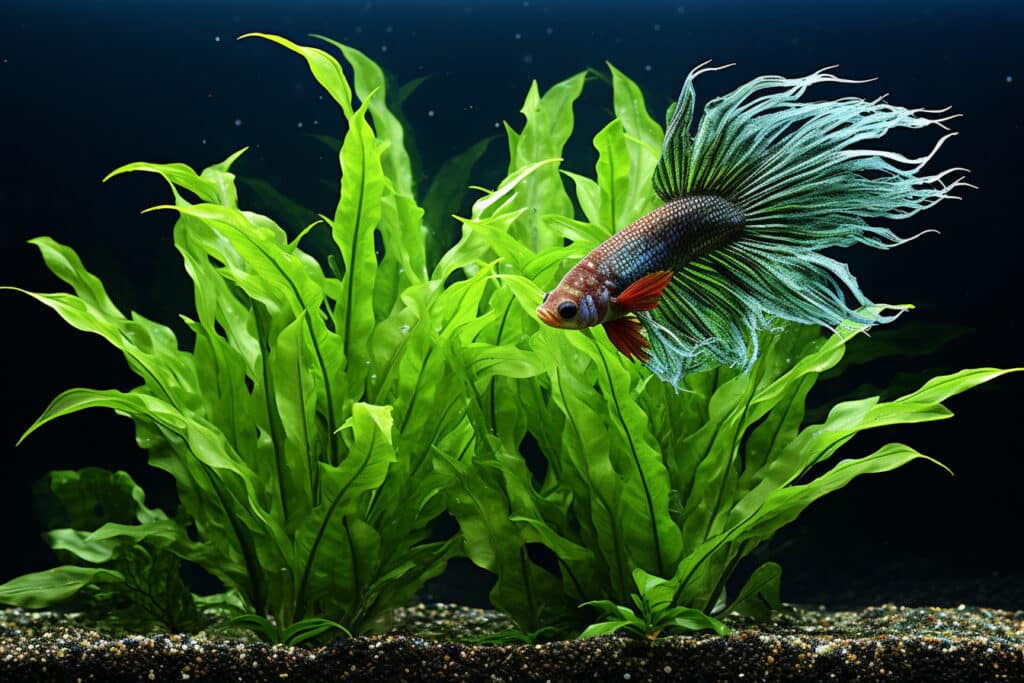
Welcome to the green side of fishkeeping, Introducing Java Fern
Meet the Java Fern, a betta fish’s underwater best friend. This lush, vibrant plant not only jazzes up your tank but also offers numerous benefits to your colorful swimmer.
In this comprehensive blog post, we’ll dive into the ins and outs of why Java Fern is the go-to plant for many betta fish enthusiasts.
Expect to learn everything from the natural habitat preferences of betta fish to why Java Fern is an aquatic match made in heaven for your finned buddy.
We’ll cover the basics of care, and the types of Java Fern available, and even dive into some of the common issues people face while caring for this aquatic greenery.
So let’s embark on this leafy journey and turn your betta fish tank into a tropical paradise!
Java Fern Varieties
You might think all Java Ferns are created equal, but that’s far from the truth! These versatile aquarium plants come in an array of shapes, sizes, and textures, offering your betta a range of leafy landscapes to explore
Below, we’ll explore some popular Java Fern varieties that would make fabulous additions to your betta fish tank.
Classic Java Fern (Microsorum Pteropus)
This is the OG, the classic Java Fern that started it all. With long, lance-shaped leaves, this variant is perfect for creating a natural backdrop or hiding spots for your betta. It’s the most common type and fairly easy to find in aquatic stores.
Java Fern Windelov
Also known as ‘Lace Java Fern’, this variant has uniquely fringed leaf tips. It’s perfect for adding visual interest to your aquarium and offering some intricate hideouts for your betta.
Trident Java Fern
Named for its trifurcate leaves, the Trident Java Fern provides a different look altogether. The leaves are smaller and more complex, offering a different aesthetic and texture. Your betta might enjoy weaving in and out of the multifaceted foliage.
Needle Leaf Java Fern
This variant has narrow, needle-like leaves, and tends to be shorter than its classic counterpart. The fine foliage creates an elegant ambiance and can make for great nesting spots.
Java Fern Narrow Leaf
The Narrow Leaf variant has slimmer leaves than the classic Java Fern but doesn’t taper to a needlepoint. Its elegant, slim leaves make it an excellent choice for those looking for a more refined foliage look.
Creeping Java Fern
This is a less common variety that grows horizontally along surfaces, creating a creeping effect. It offers a unique look and additional hiding spaces along the substrate or other aquarium decoration.
Each of these varieties has its own unique charm, and any of them can enhance the underwater world you’re creating for your betta. Feel free to mix and match to create a lush, diverse aquatic landscape your betta will love exploring!
Why Your Betta Fish Will Love Java Fern
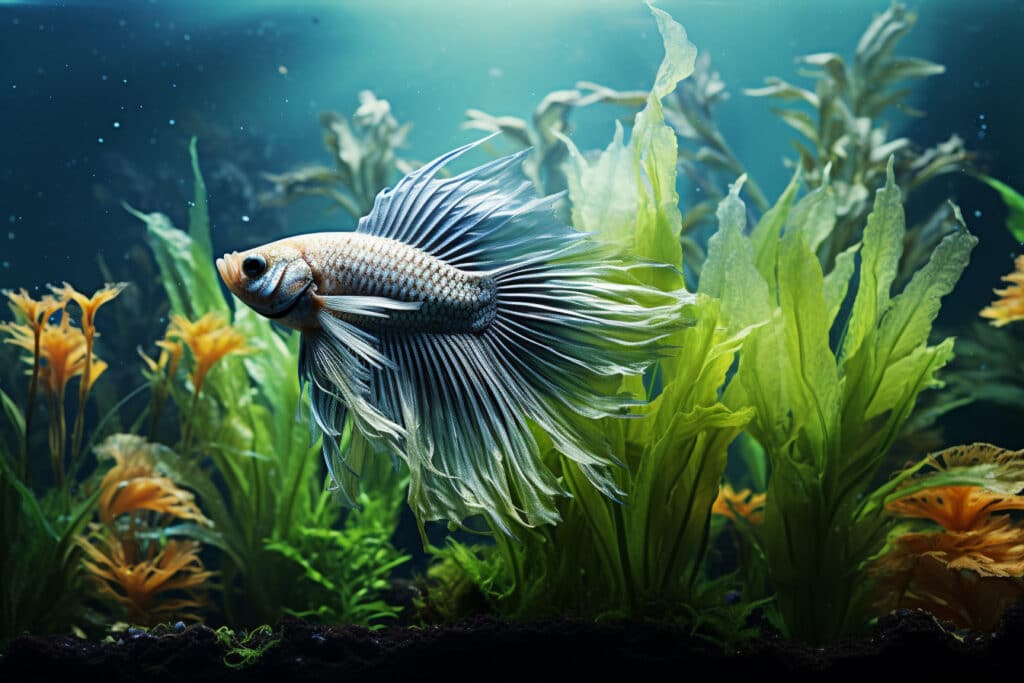
So, you’re sold on the idea of adding a little green to your betta fish’s world, but what exactly does this leafy luxury offer?
Let’s delve into the numerous ways Java Fern can elevate the living conditions of your aquatic amigo.
A Perfect Hideaway
We all need a little “me-time,” and your betta is no different.
Java Fern provides an ideal hiding spot for betta fish, offering them a refuge from the hustle and bustle of their watery world. The large, robust leaves create a canopy-like structure, offering solace and privacy whenever your betta desires.
Mental and Physical Enrichment
In the wild, bettas navigate through complex environments full of vegetation and obstacles. Java helps replicate this experience by providing physical structures to swim around, through, and under.
This not only stimulates their body but also engages their mind, preventing the boredom and stress that can sometimes occur in simpler tank setups.
A Boost to Water Quality
Aquarium plants like Java Fern play a vital role in nutrient cycling within an aquarium. They absorb excess nutrients, such as nitrates and phosphates, which can otherwise accumulate to dangerous levels in a tank. By acting as a natural filter, Java helps to maintain a cleaner and healthier living space for your betta fish.
So, whether your betta is seeking a hideout, a playground, or simply cleaner water, Java Fern offers it all. It’s like a multi-faceted, underwater Swiss Army knife that caters to the various needs of your betta, making it a must-have addition to any betta-friendly tank.
Introducing Java Fern to Your Betta Tank
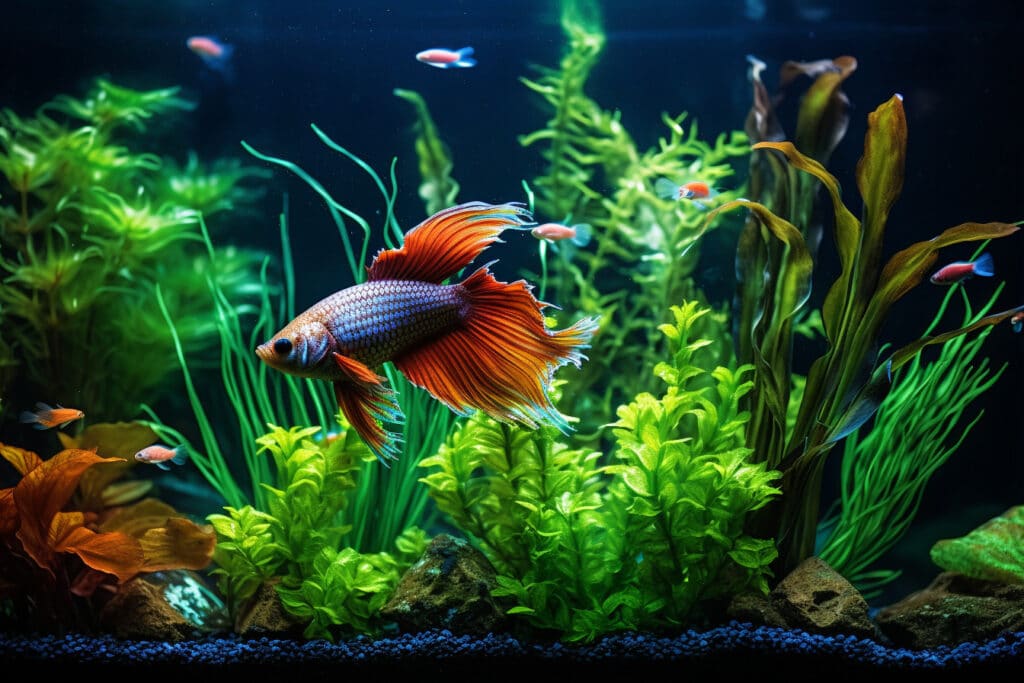
You’re convinced—Java Fern sounds like a green dream for your betta fish. Now, how do you go about introducing this wonder plant into your aquatic ecosystem? Let’s dive into a simple step-by-step guide that’ll make the process a splash!
Prepare Your Plant:
Before putting your Java into the tank, it’s important to quarantine it for a few days in a separate container filled with dechlorinated water. This helps to ensure that no unwanted pests or diseases sneak their way into your well-balanced betta home. Also, rinse the plant gently under tap water to remove any loose debris.
Choose The Right Location:
Location, location, location! Identify a spot in your tank where you’d like to place the Java. Consider areas where your betta likes to explore or hide. Make sure it doesn’t block any filter inlets or outlets.
Anchor It Down:
Java Fern doesn’t require the substrate to grow as it naturally attaches itself to rocks or driftwood. You can tie the Java’s rhizome to a rock or piece of driftwood using a fishing line or thread. If you’d like to plant it in the substrate, make sure only the roots are buried while the rhizome stays above the gravel.
Make the Introduction:
Gently place the anchored Java into the chosen location in your betta tank. Make sure to perform this step slowly to avoid startling your betta.
Observe:
Over the next few days, keep a close eye on both your betta and the newly introduced Java. Make sure the plant looks healthy and that your betta is interacting with it in a safe manner. This observation period is crucial for catching any potential issues early on.
Ongoing Care:
Finally, make sure you’re providing the right conditions for your Java to flourish. This means maintaining a consistent temperature, ensuring adequate light, and monitoring water parameters.
And there you have it! You’ve successfully added a little slice of nature to your betta’s underwater palace. Trust us, your finned friend is bound to appreciate the effort!
Java Fern Care Guideline
So, you’ve picked out the Java Fern variety that speaks to you, and you’re all set to turn your betta tank into a lush, green paradise. But how do you take care of this leafy wonder? Good news: Java Ferns are quite forgiving and can thrive with minimal fuss. Here’s your care guide to keeping your Java Fern vibrant and growing Java Fern healthy.
Lighting
Java Ferns are low-light champions. While they can tolerate a range of lighting conditions, they prefer indirect or filtered light. Too much direct light can cause the leaves to turn brown and unhealthy.
Water Conditions
Ferns are not fussy about water parameters, but they do best in soft to moderately hard water with a pH of 6.0 to 7.5. Water temperature should ideally be between 68 to 82°F (20 to 28°C), which conveniently matches the ideal range for betta fish as well.
Substrate and Positioning
Unlike many aquatic plants, Java Ferns don’t like being buried in the substrate. Instead, attach them to driftwood, rocks, or other aquarium decorations using fishing wire, thread, or even super glue. They will eventually latch on and start to grow on these surfaces.
Fertilization
While Java Ferns aren’t heavy feeders, they do benefit from occasional liquid fertilizer that’s rich in micronutrients. You can add a specially formulated aquatic plant fertilizer to your tank according to the manufacturer’s guidelines.
Water Flow
Java Ferns enjoy moderate water flow but can adapt to less dynamic conditions. A gentle current will suffice, allowing the leaves to sway elegantly while also aiding nutrient distribution.
Pruning and Maintenance
Java Ferns grow at a moderate pace. If they start to get too large or if older leaves begin to brown, prune them back using clean, sharp scissors. Make sure to remove any deteriorating leaves as they can compromise water quality.
Common Mistakes to Avoid
Java Fern is one of the most beginner-friendly aquarium plants out there, but even the easiest plants come with their pitfalls. Here are some common mistakes aquarists make when adding Java to their betta tanks—and how you can steer clear of them.
Burying the Rhizome
One of the most common mistakes is burying the rhizome (the green, horizontal stem) in the substrate. Doing this will suffocate the plant and lead to root rot. Attach your Java Fern to driftwood, rocks, or decorations instead.
Overexposure to Light
Java Ferns don’t need a ton of light, and too much direct light can lead to leaf burn. Stick to low to moderate lighting conditions, and you’ll have a happy plant.
Incorrect Water Parameters
Java Fern is forgiving when it comes to water conditions, but extremes are never good. Ensure your tank’s pH, hardness, and temperature are within the acceptable range for both your betta and the fern.
Over-fertilizing
Because they are not heavy feeders, it’s easy to over-fertilize Java Ferns. Excessive nutrients can lead to algae growth, which is unsightly and can compete with your aquarium plants for resources. Follow the manufacturer’s guidelines when using fertilizers.
Ignoring Water Flow
Although Java Ferns are adaptable, they prefer a moderate flow to help distribute nutrients. Ensure your filter output or a water pump provides this, otherwise, stagnant conditions could lead to algae or rot.
Neglecting Maintenance
Java Fern is low-maintenance, but it’s not no-maintenance. Keep an eye on leaf health, prune when needed, and remove decaying plant matter to maintain water quality.
By avoiding these common mistakes, you’ll ensure that your Java not only survives but thrives, giving your betta fish a lush, green playground to explore.
Common Health Issues, Keeping Your Java Fern Thriving
Even though Java Fern is pretty robust and beginner-friendly, it isn’t entirely immune to problems. Let’s discuss some of the common health issues that could arise and how to address them effectively.
Yellowing Leaves
If you notice the leaves turning yellow, this could indicate nutrient deficiencies, particularly a lack of iron. Consider using a specialized aquarium plant fertilizer that includes essential micro-nutrients.
Tip: Use a liquid iron supplement or comprehensive plant fertilizer containing iron. Dose according to the manufacturer’s recommendations.
Brown Spots on Leaves
Brown spots or patches on your Java Fern might be a sign of too much light. Javas prefer lower light conditions, so consider moving the plant to a shadier spot in your aquarium or reducing the lighting period.
Tip: Move the Java Fern to a less brightly lit area or reduce the daily light duration. Aim for indirect light to make your Java happy.
Leaf Curling
Leaf curling is usually a result of too much light or a water current that is too strong. Try adjusting these conditions to see if it resolves the issue.
Tip: Experiment with the water flow in your tank or relocate your Java Fern to an area with milder currents.
Holes in the Leaves
If you see small holes appearing in your Java Fern’s leaves, your plant might be lacking potassium. Make sure you are using a comprehensive liquid fertilizer that contains potassium to address this.
Tip: Dose with a high-quality liquid fertilizer that contains potassium. Follow the manufacturer’s guidelines on how much to add.
Black Spots
Tiny black spots are actually quite normal for a healthy Java Fern; these are its reproductive spores. However, large black areas that spread may indicate decay or rot—often from burying the rhizome in the substrate or too little water circulation. Remove the affected leaves and reassess your setup.
Tip: If you suspect the black spots are due to rot and not natural spores, remove the damaged leaves and ensure the rhizome isn’t buried in the substrate. Enhance water circulation around the plant.
Algae Growth
Excessive light or nutrients can cause algae to grow on your Java Fern. Algae itself won’t harm the plant, but it can be unsightly and limit the plant’s access to light. To combat this, reduce light exposure and keep nutrients at appropriate levels.
Tip: Limit light exposure to control algae. You can also introduce algae-eating species like certain snails or shrimps, but be careful they don’t go after the plant leaves.
Java Fern Melt
If your Java Fern melts or appears to be ‘melting,’ or disintegrating, this is likely due to drastic changes in water parameters. Always acclimate your plant to new water conditions slowly.
Tip: Always acclimate your Java Fern to any new water conditions slowly. Sudden changes in parameters like temperature, pH, or hardness can be detrimental.
Pests
Java Fern is generally pest-resistant but may sometimes attract snails or even shrimp that like to munch on its leaves. Keep an eye out and remove these pests if necessary.
Tip: Physically remove any pests like snails or shrimp. For stubborn infestations, consider using a plant-safe aquarium pesticide, but make sure it won’t harm your betta fish.
Following these care tips will help you successfully manage and potentially eliminate any common health issues you may encounter with your Java. This ensures a healthier, happier living environment for both the plant and your betta fish.
Understanding and recognizing these common health issues will go a long way in ensuring your Java stays healthy.
Buying Java Fern: How to Choose a Healthy Plant
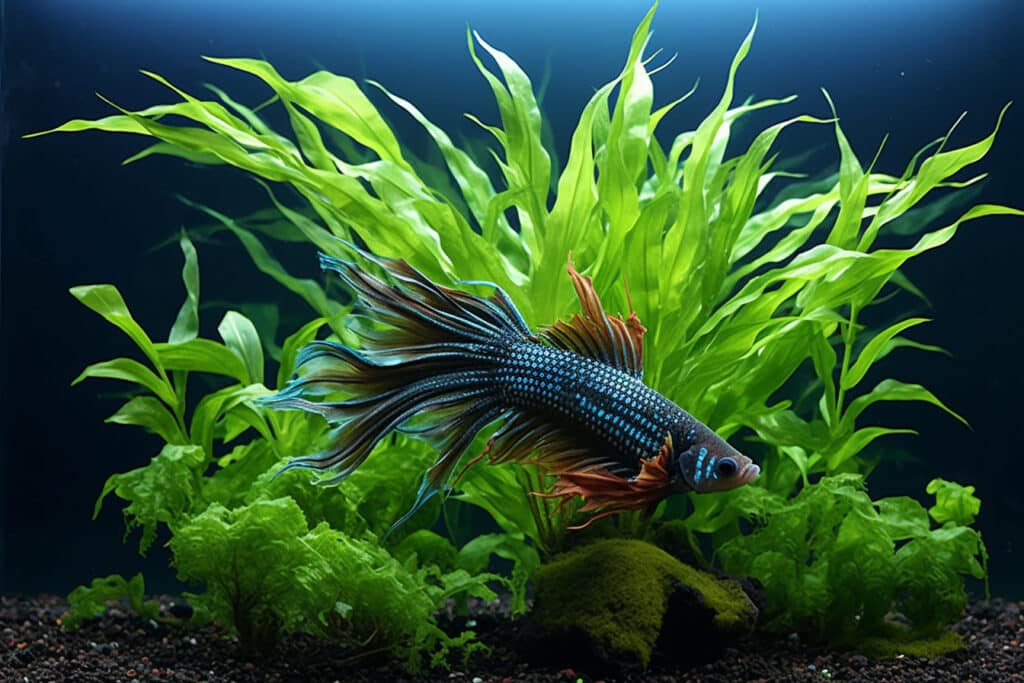
When you’re on the hunt for the perfect Java Fern to add to your betta fish tank, the choices can be overwhelming. However, knowing what to look for can simplify the process and ensure you’re bringing home a healthy, thriving plant. Here are some tips on how to choose the best Java for your aquarium:
Leaf Color: A healthy Java Fern will have vibrant green leaves. Steer clear of plants with yellow, brown, or transparent leaves, as these are signs of an unhealthy or stressed plant.
Leaf Texture: The leaves should be smooth and free from holes or tears. Damaged leaves can be an indication of nutrient deficiencies or even diseases that you don’t want to introduce into your tank.
Root Health: Take a look at the rhizome of the plant. It should be firm and free from any signs of rot or mold. A mushy rhizome is a no-go.
Pest-Free: Carefully inspect the leaves and rhizome for any signs of pests like snails or algae. While some algae are normal, excessive amounts can indicate poor care conditions.
Store Conditions: Pay attention to how the plant is kept in the store. If the aquarium it’s in looks dirty or neglected, that’s a good indication of how well the plant has been cared for.
In some cases, it’s possible to find Java Fern straight from the pet store or an aquatic botanist already attached to rocks or driftwood.Ask Questions: Don’t hesitate to ask the store staff about the care conditions of the Java Fern. Information about the lighting, water parameters, and fertilizers used can give you an insight into the plant’s health.
Check for New Growth: New leaves or small plantlets indicate a healthy, growing plant. This is usually a good sign that the plant will thrive in your aquarium.
Remember, even the healthiest Javas may show some signs of stress when first introduced to a new environment. However, if you’ve chosen a healthy plant to begin with, it will acclimate much more quickly and start thriving in your betta fish tank.
Java Fern Propagation
Java Fern propagation is a fascinating and simple process, giving you the chance to fill your betta fish tank with even more of this amazing plant. If you’ve been amazed by how well your Java is doing and want more of it without splurging on new plants, this section is for you.
The Natural Way
Java Fern naturally propagates through what’s known as “adventitious plantlets.” These little baby java fern plants form on the tips of the older leaves of the Java Fern and mature java fern as well. You’ll recognize them by their miniature leaf forms and tiny root structures. Once these plantlets have a couple of leaves and a root system that looks capable of supporting them, they are ready to be separated.
The Separation Step
To propagate your Java Fern, gently remove the leaf with the attached plantlets from the main plant. Use aquarium-safe scissors to snip them off, taking care not to harm the tiny java fern plant. Once they are separated, you can attach them to a new piece of driftwood, rock, or other decorations using a thread or a rubber band until they latch on.
Encouraging Propagation
While Java Fern naturally propagates without much intervention, there are a few things you can do to encourage the process:
Nutrients: Use liquid fertilizers designed for aquatic plants to give your Java the nutrients it needs to grow and propagate.
Optimal Water Conditions: Maintaining a stable aquatic environment is crucial. Keep the water temperature and pH levels within ideal ranges for Javas to ensure they’re at their best for propagation.
Adequate Lighting: Javas don’t require high light levels, but consistent low to medium light will help them thrive and propagate more efficiently.
Bonus Point: Aquarium Java Moss and Java Fern
In the realm of easy-to-care-for and propagated plants, Java Moss is often mentioned alongside Java Fern. These two make excellent companions in an aquarium, and the moss serves as an additional hiding and play space for your betta. Plus, Java Moss propagation is just as straightforward as that of Java Fern.
By understanding and encouraging the natural propagation of Java Fern, you’re well on your way to creating a lush, natural environment for your betta fish to thrive in.
FAQs about Java Fern in Betta Fish Tanks
Welcome to the FAQ section where we answer your burning questions about incorporating Java Fern in your betta fish tanks!
Can I Plant Java Fern in the Substrate?
Answer: Actually, Java Fern prefers to be attached to rocks, driftwood, or decorations rather than being planted in the substrate. Its rhizome can rot if buried.
Is Java Fern Safe for My Betta Fish?
Answer: Absolutely! Java Fern has soft leaves that won’t harm your betta’s delicate fins. Plus, it offers great hiding spots for your fishy friend.
Does Java Fern Require a Lot of Light?
Answer: No, Java Fern is quite adaptable and can thrive in low to moderate light conditions, making it perfect for betta fish tanks that generally don’t require high light levels.
How Fast Does Java Fern Grow?
Answer: Java Fern is a slow-growing plant. Patience is key when you’re waiting for this plant to fill out your aquarium.
Will My Betta Fish Eat Java Fern?
Answer: Betta fish are primarily carnivorous and generally don’t eat plants like Java Fern. However, they may nibble out of curiosity but it’s generally not a concern.
Do I Need to Fertilize My Java Fern?
Answer: While Java Fern is relatively easy to care for, a liquid fertilizer can give it an extra boost, especially if you notice any signs of nutrient deficiencies like yellowing leaves.
In Conclusion
Java Fern is more than just a decorative addition to your betta fish tank, it’s a multifaceted plant that offers numerous benefits, from improving water quality to providing enrichment for your betta.
Its ease of care and ability to thrive in various conditions make it a must-have for both beginner and expert aquarists.
By following our guidelines on proper introduction, care, and propagation, you’re not just planting a fern, you’re creating a healthier, more natural environment for your betta fish.
A Big Thank You!
We hope you’ve found this blog post enlightening and helpful. Your betta fish deserve the best, and understanding how to incorporate and care for Java Fern and other plants can make a world of difference in their well-being.
Thank you for taking the time to enrich your knowledge and elevate your planted aquarium game.
You might also want to read these articles:
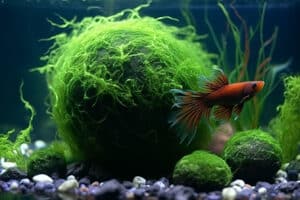
Java Moss for Betta Fish, Is It Good?
Home Java Moss for Betta Fish, Is It Good? Hello, aquatic enthusiasts! Welcome to our
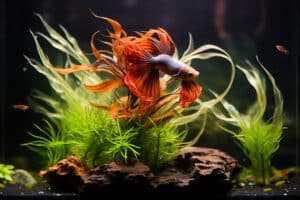
The Best Aquatic Plants For Betta Fish
Home The Best Aquatic Plants For Betta Fish Aquatic Plants for Betta Fish: Uncover the
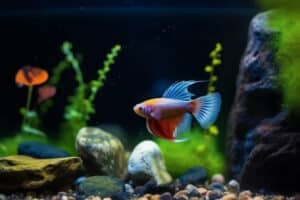
How to Choose Aquarium Rocks for Betta Fish Tanks, The Best Guide.
Aquarium Rocks for Betta Fish Tank Setting up a Betta fish aquarium is more than
